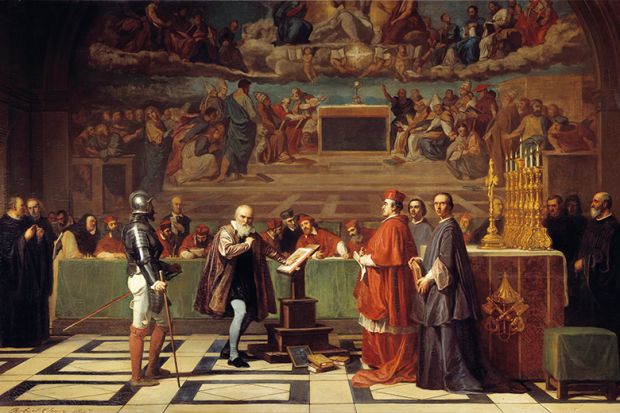Galileo’s impressive contributions to astronomy and physics deserve to be widely appreciated. Over some four decades, he slowly chipped away at the traditional support for the Earth-centred Ptolemaic/Aristotelian worldview; for example, by showing that the downward fall of a heavy body does not imply a stationary Earth and by challenging the traditional dichotomy between terrestrial and celestial regions. He also added evidence, including his analysis of tidal motion and his observations of sunspots, that increased the viability of the Copernican system. Yet, as he was fully aware, Copernicanism was not without its problems, including the absence of stellar parallax – the predicted motion of stars as seen from a moving Earth.
In his new book, Maurice Finocchiaro leads the reader along every step of Galileo’s long journey. For him, Galileo was a reasoner par excellence; he carefully weighed each argument and was attentive to its philosophical, and often religious, implications. He was judicious and avoided exaggerating the case for Copernicanism. He was fair-minded and open-minded, and even improved on his opponents’ arguments in support of the geocentric theory (before criticising them). Finocchiaro likewise presents the arguments of Galileo, his supporters and his opponents with lucidity.
Issues of religion and especially the chain of events leading to Galileo’s trial and condemnation by the Inquisition in 1633 – the so-called Galileo affair – are prominently discussed. Because it challenged specific biblical passages (especially X Joshua xii-xiii), Copernicanism was subjected to a rising tide of religious criticism, leading to Galileo’s crucial interview with Cardinal Bellarmine in 1616. While Galileo agreed to abandon the heliocentric system on Bellarmine’s advice, the minutes of the meeting written by a functionary included the much more punitive demand that he must not hold, teach or defend it in any way. This document laid the groundwork for his trial.
Finocchiaro also reflects on the proper relationship between science and Scripture. He firmly supports Galileo and those clerics who argued that science and Scripture perform separate roles and that, even though the Bible is infallible, it is “intended to teach us how to go to heaven, not how the heavens go”. In adopting this separation, he is highly critical of Pope John Paul’s 1979 speech in which he affirmed the harmony between science and religion and interpreted Galileo accordingly. He draws attention instead to aspects of the Galileo affair that demonstrate both harmony and conflict between the two domains. Moreover, rather than representing it as a clash between science and religion, as it has often been portrayed, Finocchiaro suggests that the substantive division was the opposition between conservatives and progressives, the latter group including those clerics who agreed with Galileo.
The author goes on to discuss a number of post-1633 readings of Galileo’s work. He repeatedly labels as myths those interpretations that conflict with his own and sometimes subjects their proponents to perfunctory criticism; for example, he cursorily dismisses those “secular-minded and left-leaning intellectuals, such as Bertolt Brecht, Arthur Koestler, and Paul Feyerabend, [who sought] to blame Galileo for many social and cultural problems”. Moreover, by starkly opposing myth and truth, he ignores the widespread tradition in the social sciences of understanding myth in terms of its social and psychological functions, irrespective of issues of truth or falsity.
Geoffrey Cantor is professor emeritus of the history of science at the University of Leeds.
On Trial for Reason: Science, Religion, and Culture in the Galileo Affair
By Maurice A. Finocchiaro
Oxford University Press
304pp, £25.00
ISBN 9780198797920
Published 26 September 2019




